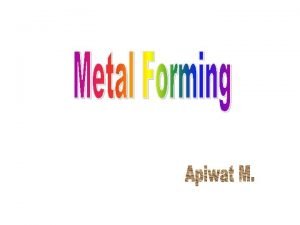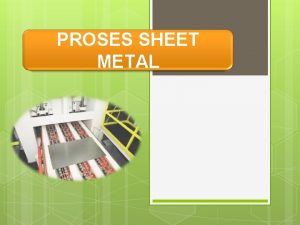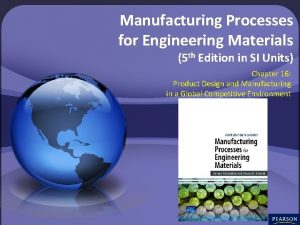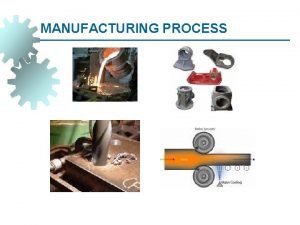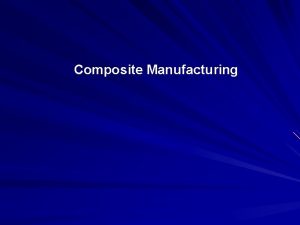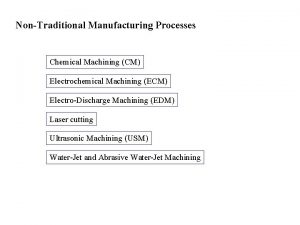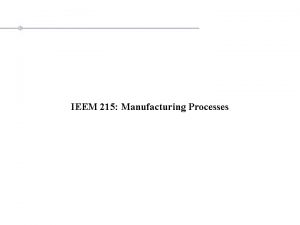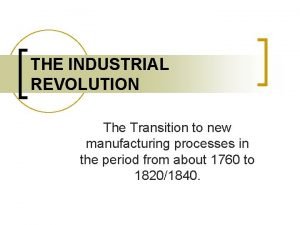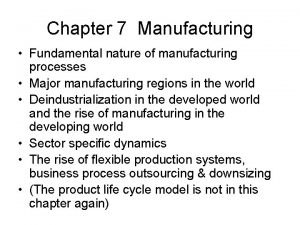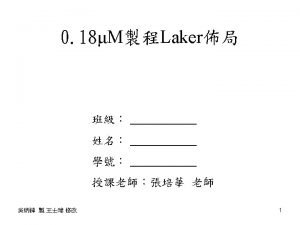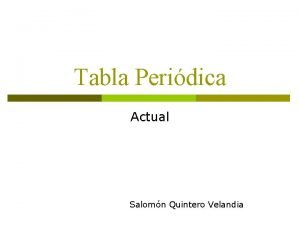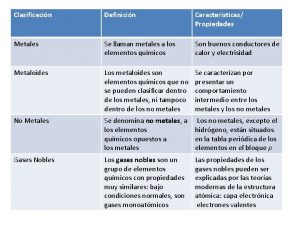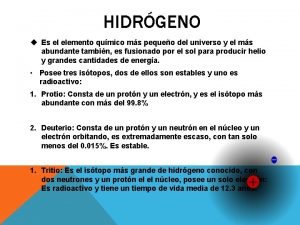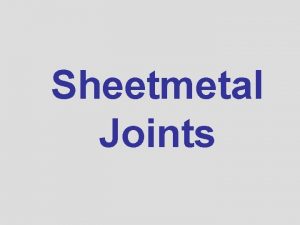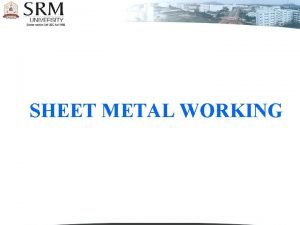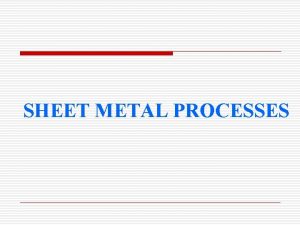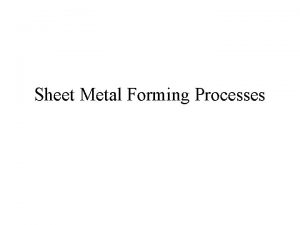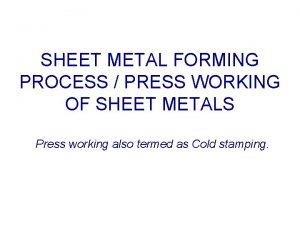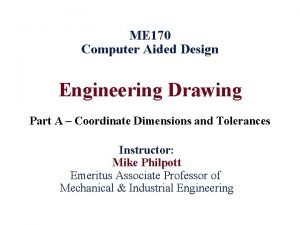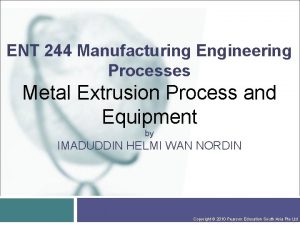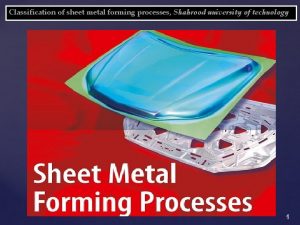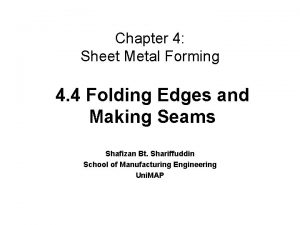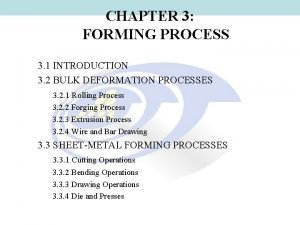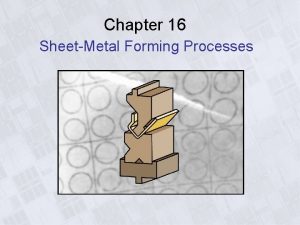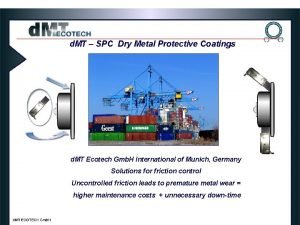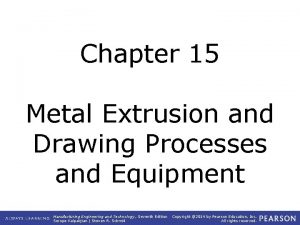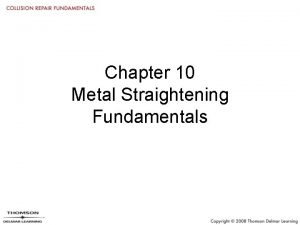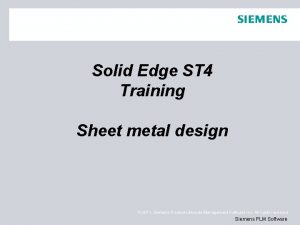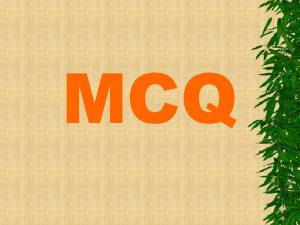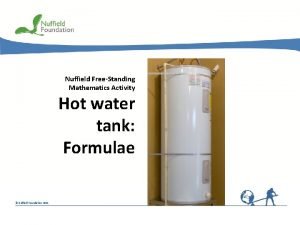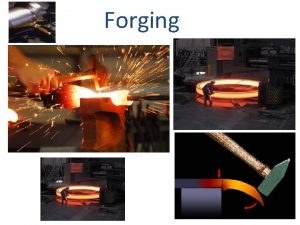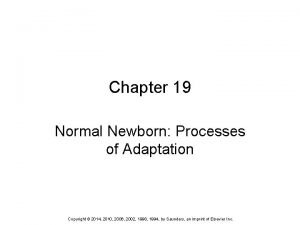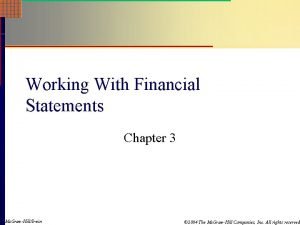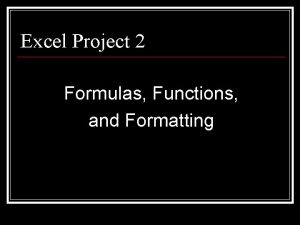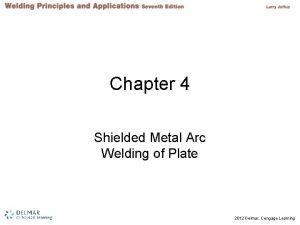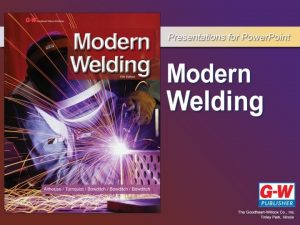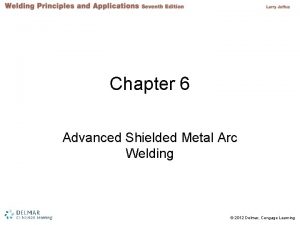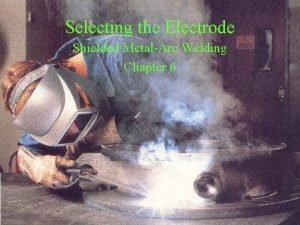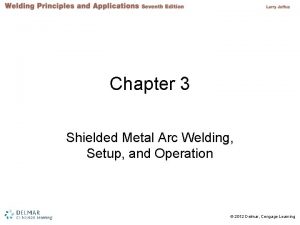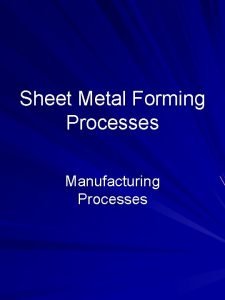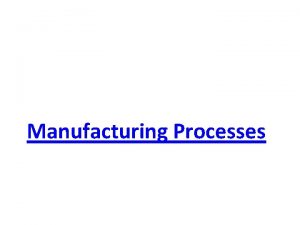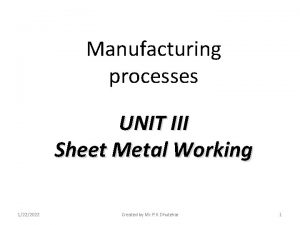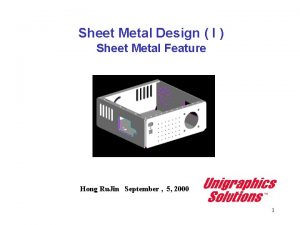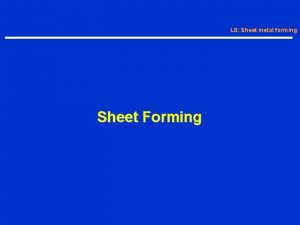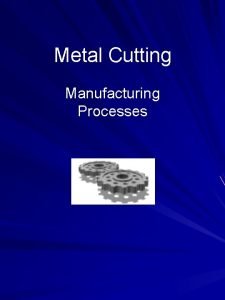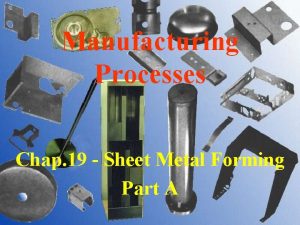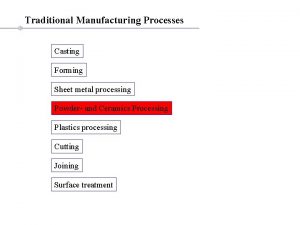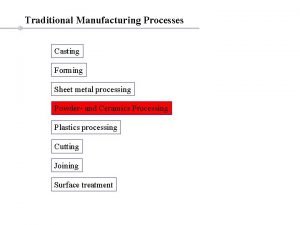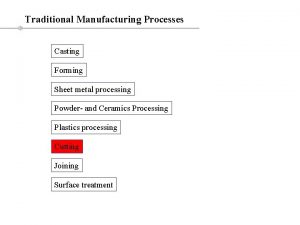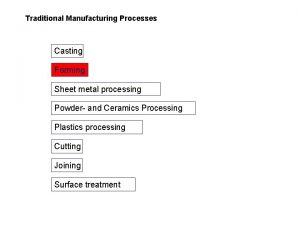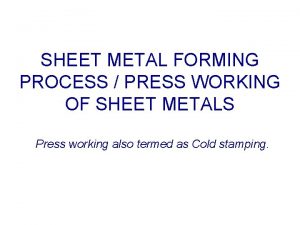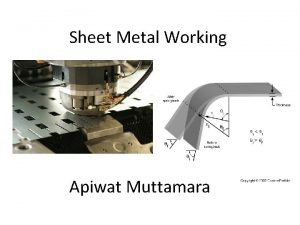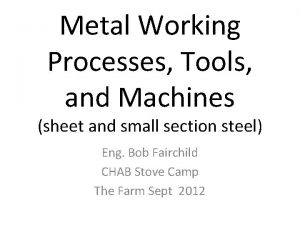Manufacturing Processes Chapter 6 Sheet Metal Working Dr























![Bending Operations Engineering Analysis of Bending [1] Metal of thickness t is bent through Bending Operations Engineering Analysis of Bending [1] Metal of thickness t is bent through](https://slidetodoc.com/presentation_image_h2/cf79f5d5ce30a3682eef58bd1f737494/image-24.jpg)

















































- Slides: 73

Manufacturing Processes Chapter 6: Sheet Metal Working Dr. Yazan Al-Zain Department of Industrial Engineering University of Jordan, Amman-Jordan 1

Introduction • Sheet Metalworking includes cutting and forming operations performed on relatively thin sheets of metal. • Typical sheet-metal thicknesses are between 0. 4 mm and 6 mm. • For thickness more than 6 mm, the stock is usually referred to as plate rather than sheet. • The sheet or plate stock used in sheet metalworking is produced by flat rolling. • The most commonly used sheet metal is low carbon steel (0. 06%– 0. 15% C). Its low cost and good formability, combined with sufficient strength for most product applications, make it ideal as a starting material. 2

Introduction • Products that include sheet or plate metal parts: automobile and truck bodies, airplanes, railway cars, locomotives, farm and construction equipment, appliances, office furniture, and more. • Accordingly, the commercial importance of sheet metalworking is significant. • Sheet metal parts are generally characterized by high strength, good dimensional accuracy, good surface finish, and relatively low cost. • Economical mass-production: designed to process the parts. Aluminum beverage cans are a prime example. 3

Introduction • Sheet-metal processing is usually performed at room temperature (cold working). • The exceptions are when the stock is thick, the metal is brittle, or the deformation is significant. These are usually cases of warm working rather than hot working. • Stamping Presses: machine tools on which most sheet-metal operations are performed. • A Punch-and-Die (Stamping Die): the tooling that performs sheet metalwork. • Stampings: the sheet-metal products. 4

Cutting Operations • Cutting of sheet metal is accomplished by a shearing action between two sharp cutting edges. Figure 20. 1 Shearing of sheet metal between two cutting edges: (1) just before the punch contacts work; (2) punch begins to push into work, causing plastic deformation; (3) punch compresses and penetrates into work causing a smooth cut surface; and (4) fracture is initiated at the opposing cutting edges that separate the sheet. Symbols v and F indicate motion and applied force, respectively, t = stock thickness, c = clearance. 5

Cutting Operations Shearing, Blanking & Punching • The three most important operations in pressworking that cut metal by the shearing mechanism: Shearing, Blanking, and Punching. – Shearing: a sheet-metal cutting operation along a straight line between two cutting edges. – Used to cut large sheets into smaller sections for subsequent pressworking operations. – Performed on a machine called a power shears, or squaring shears. – The upper blade of the power shears is often inclined to reduce the required cutting force. 6

Cutting Operations Shearing, Blanking & Punching – Shearing: Figure 20. 2 Shearing operation: (a) side view of the shearing operation; (b) front view of power shears equipped with inclined upper cutting blade. 7

Cutting Operations Shearing, Blanking & Punching • The three most important operations in pressworking that cut metal by the shearing mechanism: Shearing, Blanking, and Punching. – Blanking: involves cutting of the sheet metal along a closed outline in a single step to separate the piece from the surrounding stock. – The part that is cut out is the desired product in the operation and is called the blank. – Punching: similar to blanking except that it produces a hole, and the separated piece is scrap, called the slug. – The remaining stock is the desired part. 8

Cutting Operations Shearing, Blanking & Punching – Blanking and Punching: Figure 20. 3 (a) Blanking and (b) punching. 9

Cutting Operations Engineering Analysis of Sheet-Metal Cutting • Process parameters in sheet-metal cutting are: – Clearance between punch and die. – Stock thickness. – Type of metal and its strength. – Length of the cut. 10

Cutting Operations Engineering Analysis of Sheet-Metal Cutting • Clearance: The clearance c in a shearing operation is the distance between the punch and die, as shown in Figure 20. 1(1). – Usually range between 4% and 8% of the sheet-metal thickness. – Improper clearance: see Figure below. Figure 20. 4 Effect of clearance: (a) clearance too small causes less than optimal fracture and excessive forces; and (b) clearance too large causes oversized burr (a sharp corner on the edge caused by elongation of the metal during final separation of the two pieces). 11

Cutting Operations Engineering Analysis of Sheet-Metal Cutting • Clearance: correct value depends on sheet metal type and thickness. where c = clearance, mm; a = allowance; and t = thickness, mm. • Allowance depends on the sheet-metal type. • These calculated clearance values can be applied to conventional blanking and hole punching operations to determine the proper punch and die sizes. 12

Cutting Operations Engineering Analysis of Sheet-Metal Cutting • Whether to add the clearance value to the die size or subtract it from the punch size depends on whether the part being cut out is a blank or a slug, as illustrated below for a circular part. Punch and dies sizes for a round blank of diameter Db: Blanking punch diameter = Blanking die diameter = Punch and dies sizes for a round hole of diameter Dh: Hole punch diameter = Hole diameter = Figure 20. 5 Die size determines blank size Db; punch size determines hole size Dh. 13

Cutting Operations Engineering Analysis of Sheet-Metal Cutting • In order for the slug or blank to drop through the die, the die opening must have an angular clearance of 0. 25º to 1. 5º on each side. Figure 20. 6 Angular clearance. 14

Cutting Operations Engineering Analysis of Sheet-Metal Cutting • Cutting Forces: important as they determine the size of the press needed. where F = cutting force (N); S = shear strength of the metal (MPa); t = stock thickness (mm); and L = length of the cut edge (mm). • In case the shear strength was unknown, then: where TS = ultimate tensile strength (MPa). • Example 20. 1: 15

Cutting Operations Other Sheet-Metal-Cutting Operations • In addition to shearing, blanking, and punching, there are several other cutting operations in pressworking. – Cutoff and Parting. – Slotting, Perforating, and Notching. – Trimming, Shaving, and Fine Blanking. 16

Cutting Operations Other Sheet-Metal-Cutting Operations • Cutoff and Parting. Figure 20. 7 (a) Cutoff and (b) parting. No scrap Scrap forms 17

Cutting Operations Other Sheet-Metal-Cutting Operations • Slotting, Perforating, and Notching. Figure 20. 8 (a) Slotting (cutting out elongated or rectangular hole), (b) perforating (simultaneous punching of a pattern of holes), (c) notching (cutting out a portion of metal from the side of the sheet) and seminotching (removes a portion of metal from the interior of the sheet). 18

Cutting Operations Other Sheet-Metal-Cutting Operations • Trimming, Shaving, and Fine Blanking. Figure 20. 9 (a) Shaving (to cut unsmooth edges and get accurate dimensions) and (b) fine blanking (gives close tolerance and smooth, straight edges). 19

Bending Operations • Bending in sheet-metalwork: the straining of the metal around a straight axis. • During the bending: the metal on the inside of the neutral plane is compressed, while the metal on the outside is stretched. • The metal is plastically deformed so that the bend takes a permanent set upon removal of the stresses that caused it. • Bending produces little or no change in the thickness of the sheet metal. 20

Bending Operations Figure 20. 10 (a) Bending of sheet metal; (b) both compression and tensile elongation of the metal occur in bending. 21

Bending Operations V-Bending & Edge-Bending • Bending operations are performed using punch and die tooling. • The two common bending methods and associated tooling are Vbending, performed with a V-die; and edge-bending, performed with a wiping die. Figure 20. 11 Two common bending methods: (a) V-bending and (b) edgebending; (1) before and (2) after bending. v = motion, F = applied bending force, Fh = blank. 22

Bending Operations V-Bending & Edge-Bending • V-Bending: the sheet metal is bent between a V-shaped punch and die. – Angles ranging from very obtuse to very acute can be made with V-dies. – Generally used for low-production operations. – V-dies are relatively simple and inexpensive. • Edge-Bending: involves cantilever loading of the sheet metal. – A pressure pad is used to apply a force Fh to hold the base of the part against the die, while the punch forces the part to yield and bend over the edge of the die. – Because of the pressure pad, wiping dies are more complicated and costly than V-dies and are generally used for high-production work. 23
![Bending Operations Engineering Analysis of Bending 1 Metal of thickness t is bent through Bending Operations Engineering Analysis of Bending [1] Metal of thickness t is bent through](https://slidetodoc.com/presentation_image_h2/cf79f5d5ce30a3682eef58bd1f737494/image-24.jpg)
Bending Operations Engineering Analysis of Bending [1] Metal of thickness t is bent through an angle called the bend angle . [2] Result: a sheet-metal part with an included angle ′, where + ′= 180º. [3] Bend radius (R): specified on the inside of the part, and is determined by the radius on the tooling used to perform the operation. [4] The bend is made over the width of the workpiece w. 24 Figure 20. 12 (a) Bending of sheet metal.

Bending Operations Engineering Analysis of Bending • Bend Allowance: If the bend radius is small relative to stock thickness, the metal tends to stretch during bending. – It is important to be able to estimate the amount of stretching, so that the final part length will match the specified dimension. – The problem is to determine the length of the neutral axis before bending to account for stretching of the final bent section. where Ab = Bend allowance, mm; = bend angle, degrees; R = bend radius, mm; t = stock thickness, mm; and Kba is factor to estimate stretching. values recommended for Kba: if R <2 t, Kba = 0. 33; and if R > 2 t, Kba = 0. 50. The values of Kba predict that stretching occurs only if bend radius is small relative to sheet thickness. – This length is called the bend allowance. 25

Bending Operations Engineering Analysis of Bending • Spring Back: when the bending pressure is removed at the end of the deformation operation, elastic energy remains in the bent part, causing it to recover partially toward its original shape. – This elastic recovery is called springback. – It is the increase in included angle of the bent part relative to the included angle of the forming tool after the tool is removed. where SB = springback; ’ = included angle of the sheet-metal part, degrees; and ’t = included angle of the bending tool, degrees. Although not as obvious, an increase in the bend radius also occurs due to elastic recovery. The amount of springback increases with modulus of elasticity E and yield strength Y of the work metal. 26

Bending Operations Engineering Analysis of Bending • Amount of springback can be compensated by: – Overbending: the punch angle and radius are fabricated slightly smaller than the specified angle on the final part so that the sheet metal springs back to the desired value. – Bottoming: squeezing the part at the end of the stroke, thus plastically deforming it in the bend region. Figure 20. 13 Springback in bending shows itself as a decrease in bend angle and an increase in bend radius: (1) during the operation, the work is forced to take the radius Rt and included angle ’t is determined by the bending tool (punch in V-bending); (2) 27 after the punch is removed, the work springs back to radius R and included angle ’.

Bending Operations Engineering Analysis of Bending • Bending Force: force required to perform bending depends on geometry of the punch-and-die and strength, thickness, and length of the sheet metal. Figure 20. 14 Die opening dimension D: (a) V-die, (b) wiping die. where F = bending force, N; (TS) = tensile strength of the sheet metal, MPa; w = width of part in the direction of the bend axis, mm; t = stock thickness, mm; and D = die opening dimension as defined in Figure 20. 12, mm. This equation is based on bending of a simple beam in mechanics, and Kbf is a constant that accounts for differences encountered in an actual bending process. Its value depends on type of bending: for V-bending, Kbf = 1. 33; and for edge bending, Kbf 28 = 0. 33.

Bending Operations Other Bending & Forming Operations • Flanging: a bending operation in which the edge of a sheet-metal part is bent at a 90º angle (usually) to form a rim or flange. – Often used to strengthen or stiffen sheet metal. – The flange can be formed over a straight bend axis. – It may also involve some stretching or shrinking of the metal. • Hemming: involves cantilever loading of the sheet metal. – Bending edge of the sheet over on itself, in more than one bending step. – Often done to eliminate the sharp edge on the piece, to increase stiffness, and to improve appearance. 29

Bending Operations Other Bending & Forming Operations • Seaming: a related operation in which two sheet-metal edges are assembled. • Curling (beading): forms the edges of the part into a roll or curl. – Done for purposes of safety, strength, and aesthetics. – Applications include hinges, pots and pans. 30

Bending Operations Other Bending & Forming Operations Figure 20. 15 Flanging: (a) straight flanging, (b) stretch flanging, and (c) shrink flanging. Figure 20. 16 (a) Hemming, (b) seaming, and (c) curling. 31

Drawing • Drawing: a sheet metal forming to make cup‑shaped, box‑shaped, or other complex‑curved, hollow‑shaped parts. – Performed by placing a piece of sheet metal over a die cavity and then pushing the metal into the opening with a punch. – The blank must usually be held down flat against the die by a blankholder. – Examples on parts made by drawing: beverage cans, cooking pots, and automobile body panels. 32

Drawing Figure 20. 17 (a) Drawing of a cupshaped part: (1) start of operation before punch contacts work, and (2) near end of stroke; and (b) corresponding workpart: (1) starting blank, and (2) drawn part. Symbols: c = clearance, Db = Blank diameter, Dp = Punch diameter, Rd = die corner radius, Rp = punch corner radius, F = drawing force, Fh =33 holding force.

Drawing Mechanics of Drawing • A blank of diameter Db is drawn into a die cavity by means of a punch with diameter Dp. • The punch and die must have corner radii, given by Rp and Rd. • If the punch and die were to have sharp corners (Rp and Rd = 0), a holepunching operation would be accomplished rather than a drawing operation. • The sides of the punch and die are separated by a clearance c. This clearance in drawing is about 10% greater than the stock thickness: • The punch applies a downward force F to accomplish the deformation of the metal, and a downward holding force Fh is applied by the blankholder. 34

Drawing Mechanics of Drawing • As the punch proceeds downward toward its final bottom position, the work experiences a complex sequence of stresses and strains as it is gradually formed into the shape defined by the punch and die cavity, as shown below: Figure 20. 18 Stages in deformation of the work in deep drawing: (1) punch makes initial contact with work, (2) bending, (3) straightening, (4) friction and compression, and (5) final cup shape showing effects of thinning in the cup walls. 35

Drawing Mechanics of Drawing 1. As the punch first begins to push into the work, the metal is subjected to a bending operation. The sheet is simply bent over the corner of the punch and the corner of the die. The outside perimeter of the blank moves in toward the center in this first stage, but only slightly. 2. As the punch moves further down, a straightening action occurs in the metal that was previously bent over the die radius. The metal at the bottom of the cup, as well as along the punch radius, has been moved downward with the punch, but the metal that was bent over the die radius must now be straightened in order to be pulled into the clearance to form the wall of the cylinder. At the same time, more metal must be added to replace that being used in the cylinder wall. This new metal comes from the outside edge of the blank. This type of metal flow through a constricted space gives the drawing process its name. 36

Drawing Mechanics of Drawing 3. During this stage of the process, friction and compression play important roles in the flange of the blank. In order for the material in the flange to move toward the die opening, friction between the sheet metal and the surfaces of the blankholder and the die must be overcome. (use of lubricants to reduce friction) 4. In addition to friction, compression is also occurring in the outer edge of the blank. As the metal in this portion of the blank is drawn toward the center, the outer perimeter becomes smaller. Because the volume of metal remains constant, the metal is squeezed and becomes thicker as the perimeter is reduced. This often results in wrinkling of the remaining flange of the blank, especially when thin sheet metal is drawn, or when the blankholder force is too low. If the blankholder force is too large, it will prevent the flow resulting in possible tearing of the metal. 37

Drawing Engineering Analysis of Drawing • Measure of Drawing: – Drawing can be characterized in 3 different ways; Drawing Ratio (DR=Db/Dp), Reduction (r=(Db-Dp)/Db), and Thickness-to-Diameter Ratio (t/Db). – DR should be equal to or less than 2, while r should be less than 0. 5. – The greater the ratio, the more severe the drawing. – The t/Db is desirable to be greater than 1% (to avoid wrinkling). 38

Drawing Engineering Analysis of Drawing • Force: the drawing force required to perform a given operation can be estimated roughly by: where F = drawing force, N; t = original blank thickness, mm; TS = tensile strength, MPa; and Db and Dp are the starting blank diameter and punch diameter, respectively, mm. The constant 0. 7 is a correction factor to account for friction. • Holding force, expressed by: where F = holding force, N; Y = yield strength of the sheet metal, MPa; t = starting stock thickness, mm; Rd = die corner radius, mm. The holding force is usually about 1/3 of the drawing force. 39

Drawing Engineering Analysis of Drawing • Blank Size Determination: for the final dimensions to be achieved on the cylindrical drawn shape, the correct starting blank diameter is needed. – Must be large enough to supply sufficient metal to complete the cup. – Yet if there is too much material, unnecessary waste will result. – The blank diameter can be calculated by setting the initial blank volume equal to the final volume of the product and solving for diameter Db. 40

Drawing Other Drawing Operations • Redrawing: drawing done in more than a step, in case shape change is too severe. The second drawing step, and any further drawing steps if needed, are referred to as redrawing. Figure 20. 19 Redrawing of a cup: (1) start of redraw, and (2)endof stroke. 41

Drawing Other Drawing Operations • Redrawing: drawing done in more than a step, in case shape change is too severe. The second drawing step, and any further drawing steps if needed, are referred to as redrawing. • First draw: max. reduction 40 to 45%. Second: 30%. Third: 16%. Figure 20. 20 Redrawing of a cup: (1) start of redraw, and (2) end of stroke. 42

Drawing Other Drawing Operations • Drawing of Shapes Other Than Cylindrical Cups: square or rectangular boxes (as in sinks), cups with spherical rather than flat bases, and irregular curved forms (as in automobile body panels). • Drawing Without a Blankholder: one of the primary functions of a blankholder is to prevent wrinkling. If the t/Db ratio is large enough, drawing can be accomplished without a blankholder. • The limiting condition of this process being: Db – Dp < 5 t. • The draw die must have the shape of the funnel or cone. • Advantages: lower cost tooling and a simpler press. 43

Drawing Other Drawing Operations • Drawing Without a Blankholder: 44 Figure 20. 21 Drawing without a blankholder: (1) start of process, (2) end of stroke.

Drawing Defects in Drawing • Wrinkling in the flange: consists of a series of ridges that form radially in the undrawn flange of the workpart due to compressive buckling. • Wrinkling in the wall: If and when the wrinkled flange is drawn into the cup, these ridges appear in the vertical wall. • Tearing: an open crack in the vertical wall, usually near the base of the drawn cup, due to high tensile stresses that cause thinning and failure of the metal at this location. • Earing: the formation of irregularities (called ears) in the upper edge of a deep drawn cup, caused by anisotropy in the sheet metal. • Surface scratches: occur on the drawn part if the punch and die are not smooth or if lubrication is insufficient. 45

Drawing Defects in Drawing Figure 20. 22 Common defects in drawn parts: (a) wrinkling can occur either in the flange or (b) in the wall, (c) tearing, (d) earing, and (e) surface scratches. 46

Other Sheet-Metal-Forming Operations • Ironing: done to correct the higher thickness at the edge of the blank (refer to point 4 in drawing mechanics). • Ironing makes the cylindrical cup more uniform in wall thickness. Figure 20. 23 Ironing to achieve a more uniform wall thickness in a drawn cup: (1) start of process; (2) during process. 47

Other Sheet-Metal-Forming Operations • Coining: frequently used in sheet-metal work to form indentations and raised sections in the part (it is also a bulk deformation process as discussed in chapter 19). • Embossing: similar to coining, however, embossing dies possess matching cavity contours, the punch containing the positive contour and the die containing the negative; whereas coining dies may have quite different cavities in the two die halves Figure 20. 24 Embossing: (a) cross section of punch and die configuration during pressing; (b) finished part with embossed ribs. 48

Other Sheet-Metal-Forming Operations • Lancing: a combined cutting and bending or cutting and forming operation performed in one step to partially separate the metal from the sheet. – Example: used to make louvers in sheet metal air vents for heating and air conditioning systems in buildings. Figure 20. 25 Lancing in several forms: (a) cutting and bending; (b) and (c) two types of cutting and forming. 49

Dies and Presses for Sheet Metal Processes Dies Punch & die are the working components. Bushing & Guide pins ensure proper alignment between punch & die. Stripper prevents sheet metal from sticking to the punch after operation. Stop: prevents sheet metal from advancing through the die between cycles. (e. g. In case of coils). Figure 20. 26 Components of a punch and die for a blanking operation. 50

Dies and Presses for Sheet Metal Processes Presses • Press: a machine tool with a stationary bed and a powered ram that can be driven toward and away from the bed to perform various cutting and forming operations. – The Frame: establishes the relative positions of the bed and ram. – Punch holder is attached to the ram and the die holder is attached to a bolster plate. – Type of frame: the physical construction of the press. • Two types of frames: – Gap Frame Presses. – Straight-sided frame presses. 51

Dies and Presses for Sheet Metal Processes Presses Figure 20. 27 Components of a typical (mechanical drive) stamping press. 52

Dies and Presses for Sheet Metal Processes Presses • Two types of frames: – Gap Frame Presses: has the general configuration of the letter C and is often referred to as a C-frame. • Provide good access to the die. • Usually open in the back to permit convenient ejection of stampings or scrap. • Available in a range of sizes, with capacities up to around 1000 tons. – Straight-sided frame presses: posses greater structural rigidity for high tonnage. • Have full sides (box-like appearance). • Capacities up to 4000 tons are available. 53

Dies and Presses for Sheet Metal Processes Presses Figure 20. 28 Gap-Frame Press. . Figure 20. 29 Straight-Sided Frame Press. . 54

Sheet-Metal Operations Not Performed on Presses • There a number of sheet-metal operations not performed on conventional stamping presses. These include: – Stretch Forming. – Roll Bending and Forming. – Spinning. – High-Energy-Rate Forming Processes. 55

Sheet-Metal Operations Not Performed on Presses • Stretch Forming: a sheet-metal deformation process in which the sheet metal is intentionally stretched and simultaneously bent in order to achieve shape change. Figure 20. 30 Stretch forming: (1) start of process; (2) form die is pressed into the work with force Fdie, causing it to be stretched and bent over the form. F = stretching force. 56

Sheet-Metal Operations Not Performed on Presses • Stretch Forming: – Workpart is gripped by one or more jaws on each end and then stretched and bent over a positive die containing the desired form. – Tension level: above yield point, and force required to stretch forming: where F = stretching force, N; Yf = flow strength of the sheet metal, MPa; t = instantaneous stock thickness, mm; L = length of the sheet in a direction perpendicular to stretching, mm. – Die force Fdie can be determined by balancing vertical force components. – Suitable for low-quantity large-size production; e. g. sheet-metal used in aircraft bodies. 57

Sheet-Metal Operations Not Performed on Presses • Roll Bending: an operation in which (usually) large sheet-metal or plate-metal parts are formed into curved sections by means of rolls. – Applications: Components for large storage tanks and pressure vessels and railroad rails. – Roll Straightening: a related operation in which non-flat sheets are straightened by passing them between a series of rolls. Figure 20. 31 Roll bending: as the sheet passes between the rolls, the rolls are brought toward each other to a configuration that achieves the desired radius of curvature on the work. 58

Sheet-Metal Operations Not Performed on Presses • Roll Forming: a continuous bending process in which opposing rolls are used to produce long sections of formed shapes from coil or strip stock. – Several pairs of rolls are usually required to progressively accomplish the bending of the stock into the desired shape. – Products: include channels, pipes and tubing with seams. 59

Sheet-Metal Operations Not Performed on Presses Figure 20. 32 Roll forming of a continuous channel section: (1) straight rolls, (2) partial form, and (3) final form. Although roll forming has the general appearance of a rolling operation (and the tooling certainly looks similar), the difference is that roll forming involves bending rather than compressing the work. 60

Sheet-Metal Operations Not Performed on Presses • Spinning: a metal-forming process in which an axially symmetric part is gradually shaped over a mandrel or form by means of a rounded tool or roller. Three types of spinning: – Conventional Spinning. – Shear Spinning. – Tube Spinning. 61

Sheet-Metal Operations Not Performed on Presses – Conventional Spinning: a sheet-metal disk is held against the end of a rotating mandrel of the desired inside shape of the final part, while the tool or roller deforms the metal against the mandrel. Thickness does not change Figure 20. 33 Conventional spinning: (1) setup at start of process; (2) during spinning; and (3) completion of process. 62

Sheet-Metal Operations Not Performed on Presses – Conventional Spinning. • It bends the metal around a moving circular axis to conform to the outside surface of the axisymmetric mandrel. • Applications include: production of conical and curved shapes in low quantities. • Very large diameter parts up to 5 m or more can be made by spinning. • Alternative sheet-metal processes would require excessively high die costs. • The form mandrel in spinning can be made of wood or other soft materials that are easy to shape. • It is therefore a low-cost tool compared to the punch and die required for deep drawing, which might be a substitute process for some parts. 63

Sheet-Metal Operations Not Performed on Presses – Shear Spinning: the part is formed over the mandrel by a shear deformation process (not bending) in which the outside diameter remains constant and the wall thickness is therefore reduced. • Applied to aerospace industry to form large parts such as rocket nose cones. • Thickness of the spun nose: where tf = the final thickness of the wall after spinning, t = the starting thickness of the disk, and = the mandrel half angle. • Spinning reduction (r): 64

Sheet-Metal Operations Not Performed on Presses – Shear Spinning: tf Thickness changes Figure 20. 34 Shear spinning: (1) setup at start of process; and (2) completion of process. 65

Sheet-Metal Operations Not Performed on Presses • High-Energy-Rate Forming (HERF): processes developed to form metals using large amounts of energy applied in a very short time, include: – Explosive Forming. – Electrohydraulic Forming. – Magnetic Forming. 66

Sheet-Metal Operations Not Performed on Presses – Explosive Forming: involves the use of an explosive charge to form sheet (or plate) metal into a die cavity. • The workpart is clamped and sealed over the die, and a vacuum is created in the cavity beneath. • The apparatus is then placed in a large vessel of water. An explosive charge is placed in the water at a certain distance above the work. • Detonation of the charge results in a shock wave whose energy is transmitted by the water to cause rapid forming of the part into the cavity. 67

Sheet-Metal Operations Not Performed on Presses – Explosive Forming: Figure 20. 35 Explosive forming: (1) setup, (2) explosive is detonated, and (3) shock wave forms part and plume escapes water surface. 68

Sheet-Metal Operations Not Performed on Presses – Electrohydraulic Forming: a HERF process in which a shock wave to deform the work into a die cavity is generated by the discharge of electrical energy between two electrodes submerged in a transmission fluid (water). • Electrical energy is accumulated in large capacitors and then released to the electrodes. • Electrohydraulic forming is similar to explosive forming. The difference is in the method of generating the energy and the smaller amounts of energy that are released. • This limits electrohydraulic forming to much smaller part sizes. 69

Sheet-Metal Operations Not Performed on Presses – Electrohydraulic Forming: Figure 20. 36 Electrohydraulic forming setup. 70

Bending of Tube Stock • Bending of tube stock is more difficult than sheet stock because a tube tends to collapse and fold when attempts are made to bend it. • Special flexible mandrels are usually inserted into the tube prior to bending to support the walls during the operation. Figure 20. 37 Dimensions and terms for a bent tube: D = outside diameter of tube, R = Bend radius, t = wall thickness. 71

Bending of Tube Stock • The radius of the bend R is defined with respect to the centerline of the tube. • When the tube is bent, the wall on the inside of the bend is in compression, and the wall at the outside is in tension. • These stress conditions cause thinning and elongation of the outer wall and thickening and shortening of the inner wall. • As a result, there is a tendency for the inner and outer walls to be forced toward each other to cause the cross section of the tube to flatten. • Because of this flattening tendency, the minimum bend radius R that the tube can be bent is about 1. 5 times the diameter D when a mandrel is used and 3. 0 times D when no mandrel is used. • The exact value depends on the wall factor WF, which is the diameter D divided by wall thickness t. • Higher values of WF increase the minimum bend radius; that is, tube bending is more difficult for thin walls. Ductility is also a factor. 72

Bending of Tube Stock Figure 20. 38 Tube bending methods: (a) stretch bending, (b) draw bending, and (c) compression bending. For each method: (1) start of process, and (2) during bending. Symbols v and F indicate motion and applied force, respectively. 73
 Wholesale sheet metal forming
Wholesale sheet metal forming Sheet metal working adalah
Sheet metal working adalah Manufacturing cost vs non manufacturing cost
Manufacturing cost vs non manufacturing cost Job costing vs. process costing
Job costing vs. process costing Uncontrollable cost example
Uncontrollable cost example Manufacturing cost vs non manufacturing cost
Manufacturing cost vs non manufacturing cost Additive manufacturing vs subtractive manufacturing
Additive manufacturing vs subtractive manufacturing Manufacturing processes for engineering materials
Manufacturing processes for engineering materials Classification of production
Classification of production Introduction to manufacturing process
Introduction to manufacturing process Pultrusion process
Pultrusion process Nontraditional manufacturing processes
Nontraditional manufacturing processes Traditional manufacturing processes
Traditional manufacturing processes Industrial revolution transition
Industrial revolution transition Fundamental manufacturing processes
Fundamental manufacturing processes Concurrent processes are processes that
Concurrent processes are processes that Hot working of metal is
Hot working of metal is Hard work vs smart work
Hard work vs smart work Hot working and cold working difference
Hot working and cold working difference Differentiate between hot working and cold working
Differentiate between hot working and cold working Contoh hot working
Contoh hot working States of matter venn diagram
States of matter venn diagram Physical properties of metals
Physical properties of metals Dp periodic table
Dp periodic table Difference between metal oxides and non metal oxides
Difference between metal oxides and non metal oxides Pimp nimp
Pimp nimp Metal and nonmetal
Metal and nonmetal Periodic table pure substances
Periodic table pure substances When a metal reacts with a nonmetal the metal will
When a metal reacts with a nonmetal the metal will P
P Dr terry blanch
Dr terry blanch Propiedades y características de los elementos
Propiedades y características de los elementos Example of metals
Example of metals El sodio es metal o no metal
El sodio es metal o no metal Double grooved seam joint
Double grooved seam joint Sheet metal workshop introduction
Sheet metal workshop introduction Introduction of sheet metal
Introduction of sheet metal Surface area to volume ratio in bulk deformation process
Surface area to volume ratio in bulk deformation process Lancing process in sheet metal
Lancing process in sheet metal What is pattern development in technical drawing
What is pattern development in technical drawing Reference dimension
Reference dimension Extrusion defects
Extrusion defects Classification of sheet metal
Classification of sheet metal Types of sheet metal seams
Types of sheet metal seams Bending operation in sheet metal
Bending operation in sheet metal Forming process in sheet metal
Forming process in sheet metal Sheet metal characteristics
Sheet metal characteristics Pneumatic sheet metal cutting machine
Pneumatic sheet metal cutting machine Spc sheet metal
Spc sheet metal Extrusion drawing
Extrusion drawing Numerical modeling
Numerical modeling How to straighten bent sheet metal
How to straighten bent sheet metal Sheet metal gusset design
Sheet metal gusset design Forging is carried out at which temperature mcq
Forging is carried out at which temperature mcq Countersunk lap seam
Countersunk lap seam A storage tank is to be made from a sheet of metal 9 meters
A storage tank is to be made from a sheet of metal 9 meters Parting line in forging
Parting line in forging Stock verification sheet is also known as what sheet
Stock verification sheet is also known as what sheet Chapter 19 normal newborn processes of adaptation
Chapter 19 normal newborn processes of adaptation Chapter 8 designing and managing service processes
Chapter 8 designing and managing service processes Working with young children/answer key chapter 1
Working with young children/answer key chapter 1 Working with financial statements chapter 3
Working with financial statements chapter 3 Excel project 2
Excel project 2 Chapter 6 pay benefits and working conditions
Chapter 6 pay benefits and working conditions Chapter 5 the working cell
Chapter 5 the working cell Weaving welding definition
Weaving welding definition In alternators the welding current is produced on the ____.
In alternators the welding current is produced on the ____. Arc welding objectives
Arc welding objectives Chapter 6 shielded metal arc welding
Chapter 6 shielded metal arc welding Chapter 6 shielded metal arc welding
Chapter 6 shielded metal arc welding In alternators the welding current is produced on the
In alternators the welding current is produced on the Chapter 13 medical math
Chapter 13 medical math Conceptual physical science practice sheet chapter 2
Conceptual physical science practice sheet chapter 2 Dho digestive system
Dho digestive system
